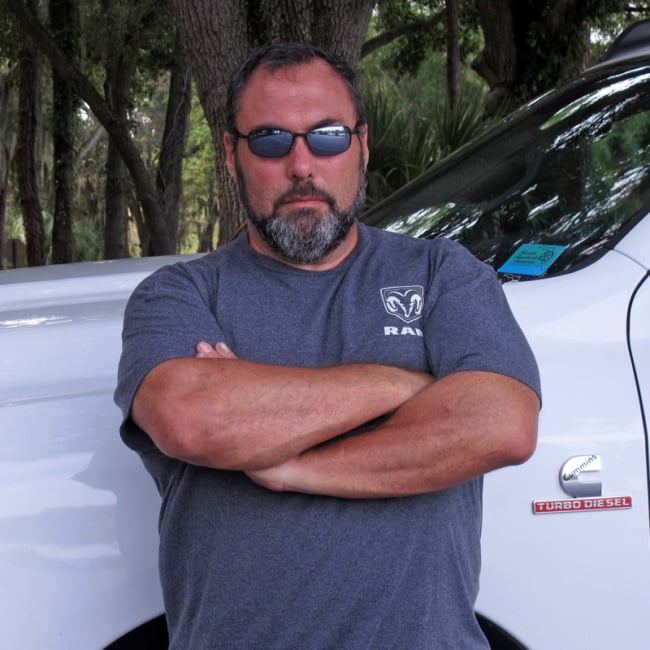
The first generation of Futurliner cica 1940. Image: www.futurliner.com
Talk about making an appearance, GM was definitely planning to do that when they started building the Futurliner in the late 1930s. It’s been said that the idea for the Parade of Progress was initiated by Charles Kettering, GM’s then Vice President of Research. The story goes, that as he walked through the GM exhibit at the 1933 World’s Fair in Chicago, he was looking at the demonstrations of science and technology used by his company, and decided to put the show on the road, and take the displays to cities and towns across America.

There is only room for three passengers, all within the elevated cockpit. The driver sits front and center, while two passengers have seats provided at the back of the cab.
The Futurliners were custom vehicles that were designed by Harley Earl. The GM-sponsored Futurliners and the Parade of Progress began to caravan the country at the end of 1940, and continued into 1941. Unfortunately, after that, the parade was put on hold by the thrusting of the United States into World War II. When the first Parade started its caravan in Lakeland, Florida, on Feb. 11, 1936, by the time it ended in Pearl Harbor, Hawaii, the Parade had covered well over a million miles, and had visited 251 towns and cities in the United States, Canada, Mexico, and Cuba. An established count for attendance has some 12.5 million people listed as visiting the show.
In 1952, the war had been over for a while, and America was headed for prosperity. This was when GM felt that the time was right to once again reignite the parade of Futurliners. So, the rebuilding began, and the transporters were refurbished so that the Parade could once again resume in 1953. As the Parade made its way across the country, it made approximately 150 stops at various larger towns and cities until 1956, when once again, the Parade ended.
An interesting note is that during the second use of the Futurliners, they were all driven by college graduates who also staffed the exhibition stops along the way. Speaking of driving, the driver’s seat of each Futurliner is roughly 10-feet from the ground.
If you were one of those fortunate enough to have the Parade stop close to your town, when you arrived for the show, you would literally find what many called a spectacle. When the Parade of Progress would reach a given destination, there people/staff organizing the stopover would arranged the caravan of Futurliners around a large tent and an information kiosk. Since each Futurliner was constructed around a self-contained stage, each one was designed to display a particular subject. The highlighted displays “predicted” the future of jet engine technology, agriculture, traffic engineering, stereophonic sound, microwave ovens, television, and other innovations. At one time, one of the Futurliners even displayed a miniature automobile assembly line. The display was fittingly named A Car is Born.

There were two Futurliners given to the Michigan State Police in 1959. One was repainted in State Police colors and converted into a traveling display to promote safety and law enforcement. The second was kept as a standby.
Despite the Futurliner’s behemoth stature, the 30,000-pound vehicles were initially powered by a Detroit Diesel engine. These original four cylinder engines were woefully underpowered, and only capable of creating 110 horsepower. Behind the engine was a simple, heavy duty truck-spec four-speed manual transmission.  Barely adequate for the job at hand, this engine/transmission combination was known for not only being underpowered, but when encountering heavy throttle situations like climbing a hill, it was prone to billow large amounts of smoke.
Barely adequate for the job at hand, this engine/transmission combination was known for not only being underpowered, but when encountering heavy throttle situations like climbing a hill, it was prone to billow large amounts of smoke.
During the “makeover” phase in 1952-1953, the Futurliners received a new six-cylinder gasoline engine. The new “Jimmy Six” produced 145 horsepower and 262 lb/ft. of torque. It was also at this time, that the manual transmission was also removed, and a four-speed automatic transmission with a two-speed splitter attached, was bolted up. In essence, the use of the splitter gave the Futurliner an eight-speed transmission. Taken from a GMC M211 military truck, this new engine was still underpowered, but we’re sure that the extra gearing added by the splitter was appreciated.
The Parade finally ended making progress in 1956, as the local stops were no longer as heavily attended, since a new medium—Television, was increasing in popularity. Ironically, that was one of the “future” things that the Parade promoted.
When the Parade of Progress was deemed to be of no more use, GM sold ten of the twelve Futurliners. The two that were not sold, were actually donated to the Michigan State Police. Under the care of the State Police, the Futurliners were renamed Safetyliners, and were then used as rolling displays to promote highway safety.
At least one Futurliner was purchased by the Reverend Oral Roberts, and used as a portable stage during his rolling ministries of the 1960s. While not confirmed, it is thought that this vehicle may have eventually been taken to Central or South America.
Of the twelve Futuliners that were built, only nine are still known to exist. Seven of those have either been restored or are at least considered to be in restorable condition. The two that were deemed beyond restoration, have had their usable parts used during the restorations of other Futurliners.



















